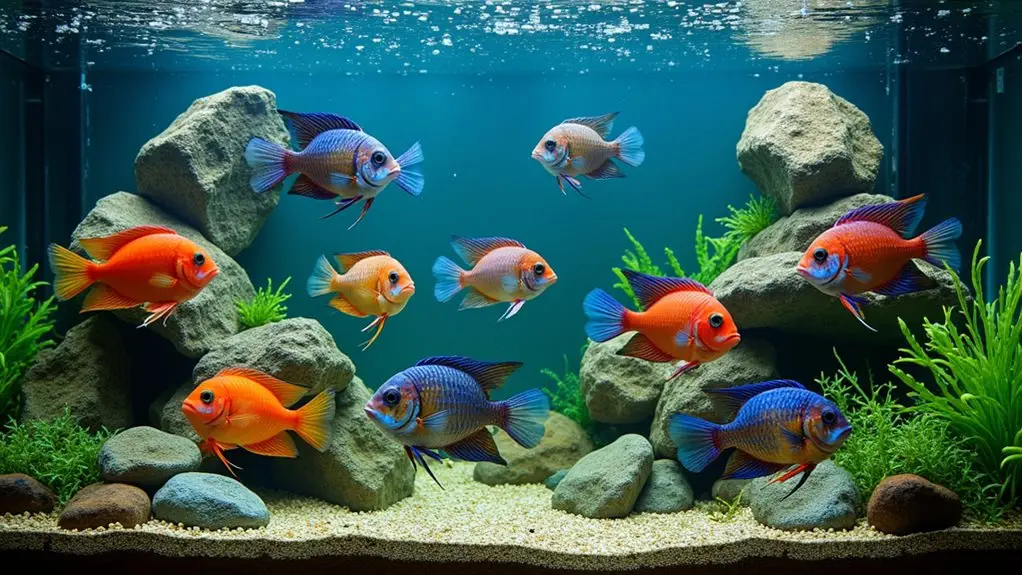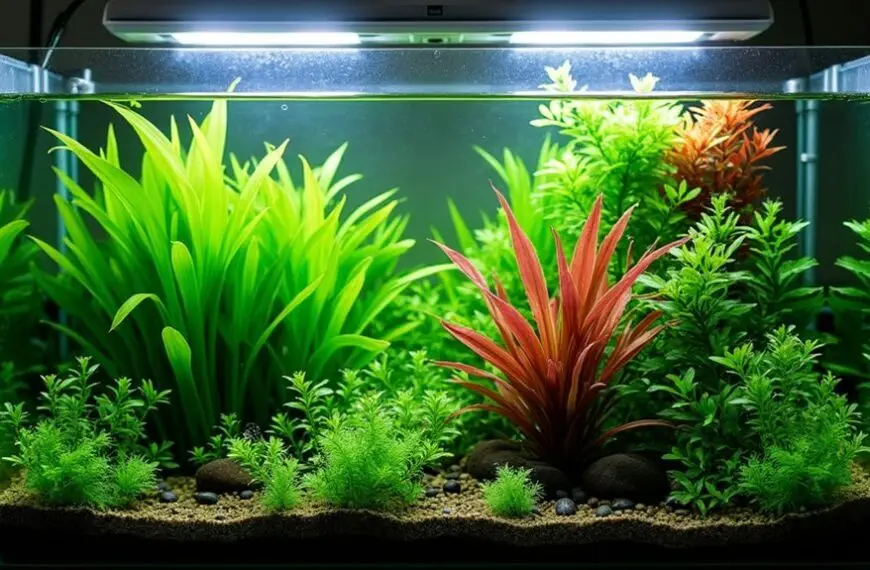Successfully matching aggressive fish requires understanding species temperaments, territorial behaviors, and water parameter needs. You’ll need to select tank mates of similar size, create visual barriers with decorations, and maintain consistent water conditions that satisfy all inhabitants. When introducing new fish, rearrange the tank setup to disrupt established territories and add multiple hiding spots. Watch for signs of stress like hiding, rapid breathing, or faded coloration. The right combinations can transform your aggressive tank into a dynamic, thriving underwater community.
Contents
- 1 Understanding Aggression in Aquarium Fish
- 2 Cichlids and Their Compatibility Factors
- 3 Territorial Behavior Management Strategies
- 4 Semi-Aggressive Community Tank Options
- 5 Predator Species Combinations That Work
- 6 Tank Size and Aquascaping for Aggressive Fish
- 7 Water Parameter Requirements for Mixed Aggressive Setups
- 8 Signs of Incompatibility to Monitor
- 9 Successful Aggressive Fish Pairings by Region
- 10 Transitioning and Acclimating New Fish to Aggressive Tanks
- 11 Frequently Asked Questions
- 11.1 Can Aggressive Fish Be Kept With Invertebrates or Freshwater Shrimp?
- 11.2 How Do Medication Treatments Affect Aggression Levels in Territorial Fish?
- 11.3 Do Fish Color Varieties of the Same Species Exhibit Different Aggression Patterns?
- 11.4 Can Aggressive Fish Recognize Their Owners or Show Affectionate Behaviors?
- 11.5 How Does Breeding Season Temporarily Alter Compatibility in Normally Compatible Aggressive Species?
- 12 Final Thoughts
Understanding Aggression in Aquarium Fish
When you’re setting up a community tank, understanding fish aggression is perhaps the most critical factor in creating a peaceful underwater world.
You’ll notice that fish, like people, have their own personalities and territorial instincts that can trigger conflicts.
Watch for behavioral cues that signal trouble brewing. Fin nipping, chasing, or a fish constantly hiding are clear signs that aggression has become a problem.
Common aggression triggers include limited space, improper tank layout, or simply mismatched species.
That peaceful angelfish might transform into a territorial tyrant during breeding season! It’s essential to research species temperament to ensure compatibility among tank inhabitants and to create a serene environment.
Cichlids and Their Compatibility Factors
When setting up a cichlid tank, you’ll need to respect their territorial nature by providing plenty of hiding spots and visual barriers to break up their claimed spaces.
You’ll find greater success if you choose tank mates of similar size to your cichlids, as this helps prevent bullying and reduces the risk of smaller fish becoming snacks.
It’s essential that all your fish companions share compatible water parameter requirements, since cichlids often prefer specific conditions like higher pH and hardness levels that mightn’t suit other tropical fish.
Territorial Boundaries Matter
Despite their vibrant colors and fascinating behaviors, cichlids often earn a reputation as the troublemakers of the aquarium world due to their territorial nature.
You’ll quickly notice how these fish mark their turf, claiming rocks, plants, or entire sections of your tank as personal property.
When setting up your cichlid community, think strategically about breaking up sightlines. Adding rock formations, driftwood, or dense plants helps reduce territorial disputes by creating natural divisions.
Each fish needs a space to call its own—when they can’t see potential rivals, boundary enforcement becomes less aggressive.
You can further minimize conflict by choosing tank mates wisely. Different species often occupy different water levels, meaning a bottom-dweller won’t compete with a mid-water swimmer for the same territory. Additionally, keeping an eye on community dynamics ensures that you select compatible species that promote a harmonious environment.
Size-Matched Tank Mates
Since cichlids come in dramatically different sizes, matching tank mates by their adult dimensions becomes essential for a peaceful aquarium community.
You’ll find that smaller species like Shell Dwellers (barely reaching 2 inches) simply can’t coexist with Oscar cichlids that grow to 12+ inches! This size compatibility directly impacts aggression levels in your aquarium.
When you’re stocking your tank, think of it like seating guests at a dinner party—you wouldn’t put a mouse at a table with hungry cats! To maintain a harmonious environment, consider incorporating low-maintenance fish that can help stabilize water conditions and reduce stress in the tank.
Research each cichlid’s adult size before purchase, not just their cute juvenile dimensions. Many hobbyists make this mistake and end up with a bullied fish or, worse, a snack.
Compatible Water Parameters
Although cichlids are incredibly diverse, their water parameter requirements don’t follow a one-size-fits-all approach.
You’ll need to research your specific cichlid species carefully, as water chemistry needs vary dramatically between African and South American varieties.
African cichlids from Lake Malawi and Lake Tanganyika thrive in hard, alkaline water with pH levels between 7.8-8.6, while South American species like Angelfish and Discus prefer softer, slightly acidic conditions with pH levels of 6.0-7.0.
Mixing these groups is asking for trouble! When you select tank mates, guarantee they share similar water parameter preferences.
Testing your water regularly becomes essential when keeping cichlids.
Small shifts in parameters that other fish might tolerate can stress these sensitive beauties, leading to disease or aggression. Regular testing for ammonia levels is crucial in maintaining a healthy environment for your cichlids.
Territorial Behavior Management Strategies
When fish establish territories in your aquarium, they’ll often defend these areas with surprising determination and aggression. Understanding these territorial disputes can help you prevent serious conflicts before they escalate.
Most aggression triggers are related to limited space, breeding behavior, or competition for resources like food and hiding spots.
To manage territorial behavior effectively, try these practical strategies: rearrange decorations periodically to disrupt established territories, add visual barriers like plants or rocks to block sightlines, and guarantee you’re providing enough hiding places for all fish.
Introducing all new fish simultaneously can also reduce the “home field advantage” that established residents enjoy. During feeding time, scatter food widely to prevent competition hotspots. Additionally, ensure your tank is appropriately stocked with compatible species to minimize aggressive encounters.
If you notice persistent aggression, you may need to reconsider your stocking choices or upgrade to a larger tank.
Semi-Aggressive Community Tank Options
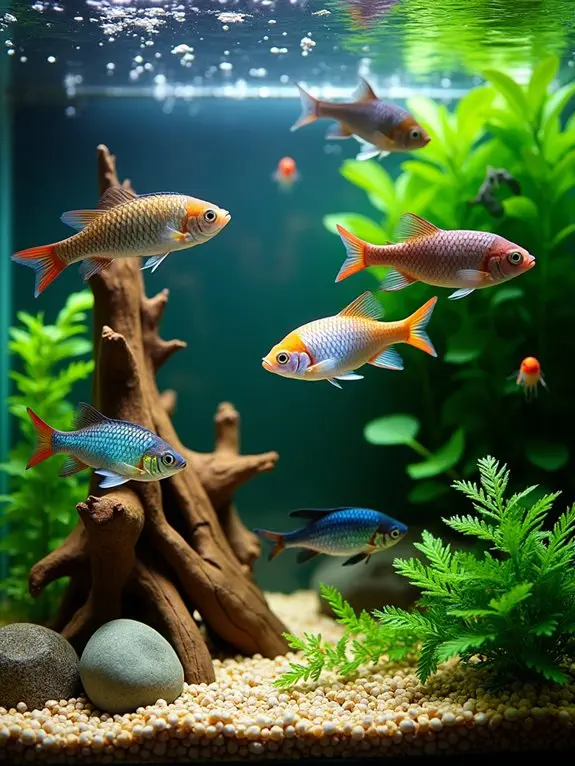
When setting up a semi-aggressive community tank, you’ll need to carefully choose fish combinations that respect territories while creating visual harmony.
Your tank setup should include plenty of hiding spots, broken sight lines using plants and decorations, and adequate swimming space for all inhabitants.
Barbs, larger tetras, and peaceful cichlids often make excellent tankmates in this setup, provided you’ve created enough distinct territories for each fish to claim as their own. Additionally, ensure to regularly test water parameters to maintain a healthy environment for your fish.
Ideal Fish Combinations
While many aquarists shy away from semi-aggressive species, these dynamic fish can create a fascinating and vibrant aquarium when properly combined.
You’ll want to select tank mates that share similar water parameters but occupy different levels of the water column to minimize territorial disputes.
When establishing ideal fish behavior in your semi-aggressive setup, it’s important to understand that a social hierarchy will naturally develop.
Tiger barbs pair well with larger tetras, rainbow fish, and peaceful catfish species. Gouramis can coexist with silver dollars and certain loaches.
You might also try angelfish with corydoras catfish and larger rasboras.
Remember to introduce fish simultaneously when possible, or add more aggressive species last to prevent established territories from being defended too vigorously. Additionally, ensuring you provide a well-planted environment can help reduce stress and promote harmony among tank mates.
Tank Setup Essentials
Three essential elements form the foundation of any successful semi-aggressive community tank: proper space, strategic aquascaping, and adequate hiding spots.
You’ll want to invest in quality tank materials that provide durability and safety for your feistier fish. A 55-gallon aquarium is typically your minimum starting point, giving territorial species room to establish boundaries without constant confrontation.
Your filtration systems should be robust, handling about 4-5 times your tank’s volume per hour, as semi-aggressive fish often produce more waste. Effective water circulation is crucial in maintaining a healthy environment for all tank inhabitants.
Don’t skimp here—your filter is your tank’s lifeline!
Create depth with caves, driftwood, and densely planted areas where submissive fish can retreat when tensions rise.
Predator Species Combinations That Work
Although many aquarists believe predatory fish can’t coexist peacefully, certain combinations actually thrive together in the same tank.
You’ll need to understand predator behavior and fish hierarchy to successfully create these dynamic communities. Large cichlids, for example, often establish territories without lethal aggression when given adequate space and hiding spots.
Try pairing oscars with peaceful bottom-dwellers like larger plecos, or combine predatory catfish with fast-swimming tetras that stay in different water columns.
You might be surprised how well tiger barbs and angelfish coexist after initial hierarchy establishment!
The secret? Match fish by size, swimming level, and temperament.
When you provide ample space, proper feeding schedules, and carefully introduce new specimens, even notorious hunters can become surprisingly cooperative roommates.
Who knew your predators could learn to play nice?
Tank Size and Aquascaping for Aggressive Fish
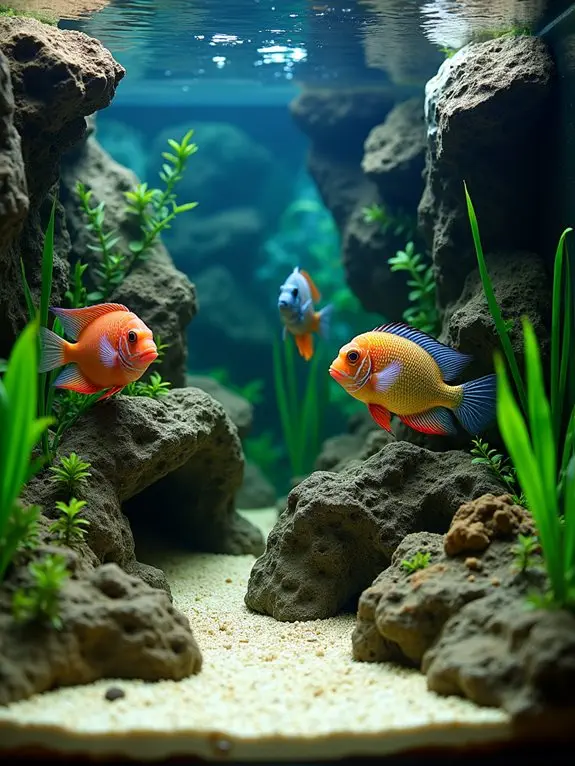
When setting up a home for aggressive fish, you’ll need to contemplate their specific space requirements, which often differ dramatically between species.
Your tank should be large enough to accommodate not just the fish’s adult size, but also their natural territorial behaviors that require sufficient swimming room.
You can create effective boundaries using rocks, driftwood, and plants strategically placed to break sight lines and provide hiding spots, helping your feisty swimmers establish their own comfortable territories.
Space Requirements Vary
Since every aggressive fish species has its own territorial needs, the “one inch of fish per gallon” rule simply doesn’t apply in community tanks with territorial inhabitants. Your Oscar might need 30+ gallons alone, while cichlids require carefully structured territories to reduce aggression.
Smart space utilization strategies can make a huge difference in fish harmony!
When planning your tank, remember that vertical swimmers like angelfish need height, while bottom-dwellers like plecos need floor space.
You’ll want to implement habitat enrichment techniques such as creating multiple line-of-sight breaks with rocks, driftwood, and plants. This gives your fish places to claim as their own and retreat when stressed. Additionally, understanding proper tank size is essential for maintaining stable water temperatures and quality.
Don’t skimp on tank size—it’s always better to go bigger when housing aggressive species. Your fish will thank you with better colors and fewer territorial disputes!
Territories Need Boundaries
Because aggressive fish instinctively establish and defend their territory, proper boundaries become essential for peaceful coexistence in your aquarium.
Creating distinct zones helps prevent territorial disputes and reduces stress among your finned friends. When designing your tank’s layout, focus on breaking sightlines and creating natural barriers that support boundary enforcement.
Here are three effective ways to establish territories:
- Use large rocks and driftwood to create caves and hiding spots where fish can retreat and claim as their own.
- Plant tall, dense vegetation in strategic locations to block visual contact between rival fish.
- Arrange decorations to form distinct “neighborhoods” with clear boundaries using different substrate colors or heights.
You’ll notice fewer aggressive encounters when each fish has a space they can truly call home. Additionally, selecting the right substrate depth is critical for ecosystem stability, providing a foundational layer that supports the tank’s overall health and balance.
Water Parameter Requirements for Mixed Aggressive Setups
Although aggressive fish can make stunning additions to your aquarium, they’ll only thrive together if you maintain precise water parameters.
Water chemistry plays a critical role in keeping your feisty swimmers healthy and less irritable. Monitor pH stability closely, as fluctuations can stress your fish and trigger increased aggression.
You’ll need to test your water weekly, keeping ammonia and nitrites at zero and nitrates below 20ppm. Remember, stressed fish become more territorial!
Many aggressive species prefer slightly different conditions – cichlids may want harder, alkaline water while some predatory catfish prefer softer, more acidic environments. Finding the middle ground is your challenge.
Don’t forget temperature requirements either. A variance of just a few degrees can make the difference between peaceful coexistence and all-out warfare in your tank.
Signs of Incompatibility to Monitor

Keeping the water perfect doesn’t guarantee your fish will get along! Even in aggressive fish communities, there’s a difference between normal roughhousing and problematic aggression. You’ll need to watch for behavioral changes that signal trouble brewing beneath the surface.
Look for these stress indicators daily:
- Fish hiding constantly behind decorations, breathing rapidly, or developing faded coloration – these are classic stress indicators that shouldn’t be ignored.
- Disrupted social hierarchy where one fish becomes excessively dominant, preventing others from accessing food or territory.
- Extreme feeding aggression where fish attack tankmates instead of just competing for food, often resulting in torn fins or scale damage.
Don’t wait until physical injuries appear! Early intervention when you notice these warning signs can save your aquatic friends.
Successful Aggressive Fish Pairings by Region
When you’re creating an aggressive community tank, understanding regional compatibility can make all the difference between harmony and chaos. Fish from similar geographic regions often share aggressive behavior patterns that have evolved to work together in their native habitats.
The African cichlid tank is a classic example where species from Lake Malawi can coexist despite their territorial nature. They’ve adapted to the same water parameters and understand each other’s aggression signals.
Fish from Lake Malawi speak the same aggressive language, making territorial harmony possible in the African cichlid community.
Similarly, you’ll find success pairing South American cichlids like Oscars and Severums, who’ve developed compatible social structures.
For Asian waters, try combining betta fish with peaceful bottom dwellers like kuhli loaches. They occupy different parts of the tank, reducing confrontation.
Transitioning and Acclimating New Fish to Aggressive Tanks
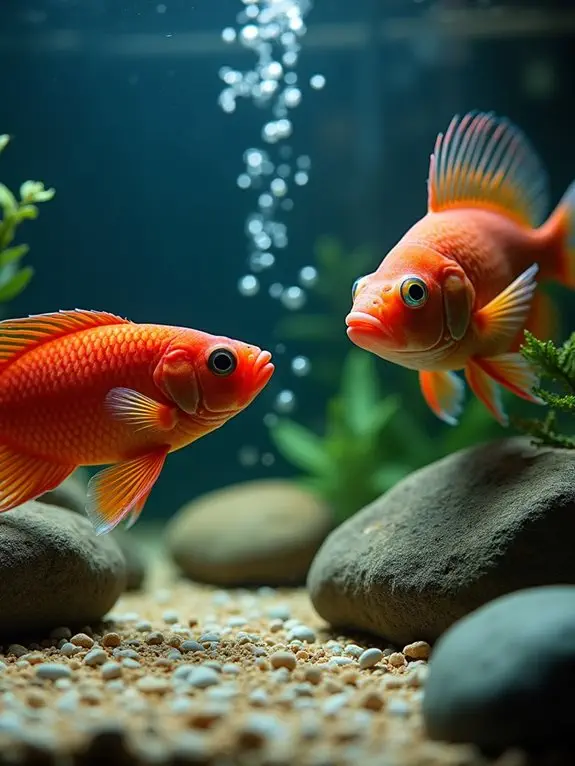
Successfully introducing new fish to an established aggressive tank requires careful planning and patience. Proper acclimation techniques can make the difference between a seamless change and disaster.
You’ll want to focus on stress reduction for both your existing fish and newcomers.
Try these proven methods for better results:
- Rearrange decorations and hiding spots before adding new fish, disrupting established territories and reducing immediate aggression.
- Use a quarantine tank for 2-3 weeks to observe the new fish’s health while allowing your aggressive residents to reset their hierarchy.
- Introduce new fish after lights-out, when territorial fish are less active, giving newcomers time to find hiding spots before morning.
Frequently Asked Questions
Can Aggressive Fish Be Kept With Invertebrates or Freshwater Shrimp?
You shouldn’t keep aggressive fish with invertebrates or freshwater shrimp. Shrimp safety is compromised as they’ll likely become expensive fish food. Invertebrate compatibility is poor with most aggressive species that view them as prey.
How Do Medication Treatments Affect Aggression Levels in Territorial Fish?
Certain medication types can temporarily reduce aggression levels in your territorial fish. You’ll notice some meds sedate fish, while others treat underlying health issues that might be triggering heightened aggression. Monitor responses carefully during treatment.
Do Fish Color Varieties of the Same Species Exhibit Different Aggression Patterns?
Yes, you’ll notice color variations within the same species can display different aggression levels. Some brighter variants might be more territorial, while others show milder temperaments due to genetic differences affecting their behavior.
Can Aggressive Fish Recognize Their Owners or Show Affectionate Behaviors?
Yes, aggressive fish can develop owner recognition, approaching you when you’re near the tank. They’ll show affectionate behaviors like following your finger or eating from your hand with regular, positive interactions.
How Does Breeding Season Temporarily Alter Compatibility in Normally Compatible Aggressive Species?
During breeding season, you’ll notice your fish display heightened territorial behavior and temporary aggression toward tank mates. They’re protecting potential mates and nesting sites, disrupting your normally peaceful community until breeding activities conclude.
Final Thoughts
Your aggressive fish tank doesn’t have to be a battleground! With careful selection, proper territory management, and attention to compatibility cues, you’ll create a thriving ecosystem of personality-packed fish. Remember, success comes from matching temperaments, providing adequate space, and monitoring interactions. You’ve now got the tools to balance these underwater powerhouses in your aquarium. Enjoy your dynamic display of nature’s more assertive swimmers—they’re worth the extra effort!

